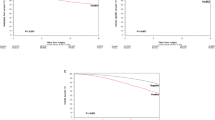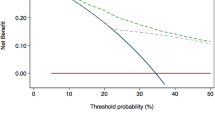Abstract
This study provides further insights into those preoperative parameters that predict side-specific risk of pathological stage in men undergoing radical prostatectomy (RP). The transrectal ultrasound-guided tissue biopsy cores obtained from the right and left sides of the prostate were collected in separate jars and examined independently according to the side of origin in 1250 men with clinically localized prostate cancer who underwent RP. The side-specific biopsy specimens were examined for Gleason score, number of positive cores, percentage of positive cores, percent tumor volume in the biopsy specimens and the presence of perineural invasion. All of the surgical specimens were processed and analyzed by pathologists at NYUMC using a standardized protocol. The surgical specimens were examined for side-specific extracapsular extension (ECE) and seminal vesicle invasion (SVI). Using a univariate analysis, age, serum prostate-specific antigen (PSA), prostate volume, clinical stage, Gleason score, number of positive biopsies, percent positive biopsy cores, percent volume of prostate cancer in cores and perineural invasion were all significant predictors of both ECE and SVI. A multivariate analysis was performed to determine the independent predictors of ECE and SVI. Serum PSA, biopsy Gleason score, percent volume of biopsy cores with cancer and perineural invasion were independent predictors of side-specific ECE. Age, serum PSA, Gleason score and prostate volume were independent predictors of side-specific SVI. Our study identified previously unrecognized independent predictors of side-specific ECE and SVI. Our study also provides evidence that the independent predictors of ECE and SVI are different.
This is a preview of subscription content, access via your institution
Access options
Subscribe to this journal
Receive 4 print issues and online access
$259.00 per year
only $64.75 per issue
Buy this article
- Purchase on Springer Link
- Instant access to full article PDF
Prices may be subject to local taxes which are calculated during checkout
Similar content being viewed by others
References
Partin AW, Yoo J, Carter HB, Pearson JD, Chan DW, Epstein JI et al. The use of prostate specific antigen, clinical stage and Gleason score to predict pathological stage in men with localized prostate cancer. J Urol 1993; 150: 110.
D'Amico AV, Whittington R, Malkowicz SB, Schultz D, Blank K, Broderick GA et al. Biochemical outcome after radical prostatectomy, external beam radiation therapy, or interstitial radiation therapy for clinically localized prostate cancer. JAMA 1998; 280: 969.
Makarov DV, Trock BJ, Humphreys EB, Mangold LA, Walsh PC, Epstein JI et al. Updated nomogram to predict pathologic stage of prostate cancer given prostate-specific antigen level, clinical stage, and biopsy Gleason score (Partin tables) based on cases from 2000 to 2005. Urology 2007; 69: 1095.
May M, Knoll N, Siegsmund M, Fahlenkamp D, Vogler H, Hoschke B et al. Validity of the CAPRA score to predict biochemical recurrence-free survival after radical prostatectomy. Results from a european multicenter survey of 1,296 patients. J Urol 2007; 178: 1957.
Catalona WJ, Basler JW . Return of erections and urinary continence following nerve sparing radical retropubic prostatectomy. J Urol 1993; 150: 905.
Lepor H, Walsh PC . Long-term results of radical prostatectomy in clinically localized prostate cancer: experience at the Johns Hopkins Hospital. NCI Monogr 1988; 7: 117b.
Talcott JA, Rieker P, Propert KJ, Clark JA, Wishnow KI, Loughlin KR et al. Patient-reported impotence and incontinence after nerve-sparing radical prostatectomy. J Natl Cancer Inst 1997; 89: 1117.
Bellina M, Mari M, Ambu A, Guercio S, Rolle L, Tampellini M . Seminal monolateral nerve-sparing radical prostatectomy in selected patients. Urol Int 2005; 75: 175.
Poissonnier L, Chapelon JY, Rouviere O, Curiel L, Bouvier R, Martin X et al. Control of prostate cancer by transrectal HIFU in 227 patients. Eur Urol 2007; 51: 381.
Blana A, Murat FJ, Walter B, Thuroff S, Wieland WF, Chaussy C et al. First Analysis of the Long-Term Results with Transrectal HIFU in Patients with Localised Prostate Cancer. Eur Urol 2008; 53: 1194–1201.
Polascik TJ, Nosnik I, Mayes JM, Mouraviev V . Short-term cancer control after primary cryosurgical ablation for clinically localized prostate cancer using third-generation cryotechnology. Urol 2007; 70: 117–121.
Taneja SS, Penson DF, Epelbaum A, Handler T, Lepor H . Does site specific labeling of sextant biopsy cores predict the site of extracapsular extension in radical prostatectomy surgical specimen. J Urol 1999; 162: 1352.
Walsh PC, Lepor H, Eggleston JC . Radical prostatectomy with preservation of sexual function: anatomical and pathological considerations. Prostate 1983; 4: 473.
Bostwick DG, Foster CS . Pathology of the Prostate. Philadelphia: W.B. Saunders Co., p.172, 1998.
Egan AJ, Bostwick DG . Prediction of extraprostatic extension of prostate cancer based on needle biopsy findings: perineural invasion lacks significance on multivariate analysis. Am J Surg Pathol 1997; 21: 1496.
Bostwick DG, Qian J, Bergstralh E, Dundore P, Dugan J, Myers RP et al. Prediction of capsular perforation and seminal vesicle invasion in prostate cancer. J Urol 1996; 155: 1361.
Hassan MO, Maksem J . The prostatic perineural space and its relation to tumor spread: an ultrastructural study. Am J Surg Pathol 1980; 4: 143.
Freedland SJ, Isaacs WB, Platz EA, Terris MK, Aronson WJ, Amling CL et al. Prostate size and risk of high-grade, advanced prostate cancer and biochemical progression after radical prostatectomy: a search database study. J Clin Oncol 2005; 23: 7546.
Epstein JI, Walsh PC, Carmichael M, Brendler CB . Pathologic and clinical findings to predict tumor extent of nonpalpable (stage T1c) prostate cancer. JAMA 1994; 271: 368.
Ohori M, Kattan MW, Koh H, Maru N, Slawin KM, Shariat S et al. Predicting the presence and side of extracapsular extension: a nomogram for staging prostate cancer. J Urol 2004; 171: 1844.
Author information
Authors and Affiliations
Corresponding author
Rights and permissions
About this article
Cite this article
Sankin, A., Tareen, B. & Lepor, H. Side-specific factors associated with extracapsular extension and seminal vesicular invasion in men undergoing open radical retropubic prostatectomy. Prostate Cancer Prostatic Dis 12, 204–208 (2009). https://doi.org/10.1038/pcan.2009.2
Received:
Accepted:
Published:
Issue Date:
DOI: https://doi.org/10.1038/pcan.2009.2
Keywords
This article is cited by
-
MRI-derived tumor volume as a predictor of biochemical recurrence and adverse pathology in patients after radical prostatectomy: a propensity score matching study
Journal of Cancer Research and Clinical Oncology (2023)



